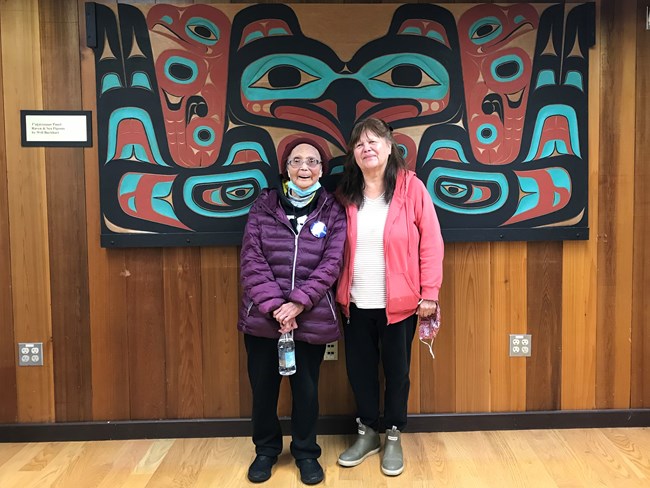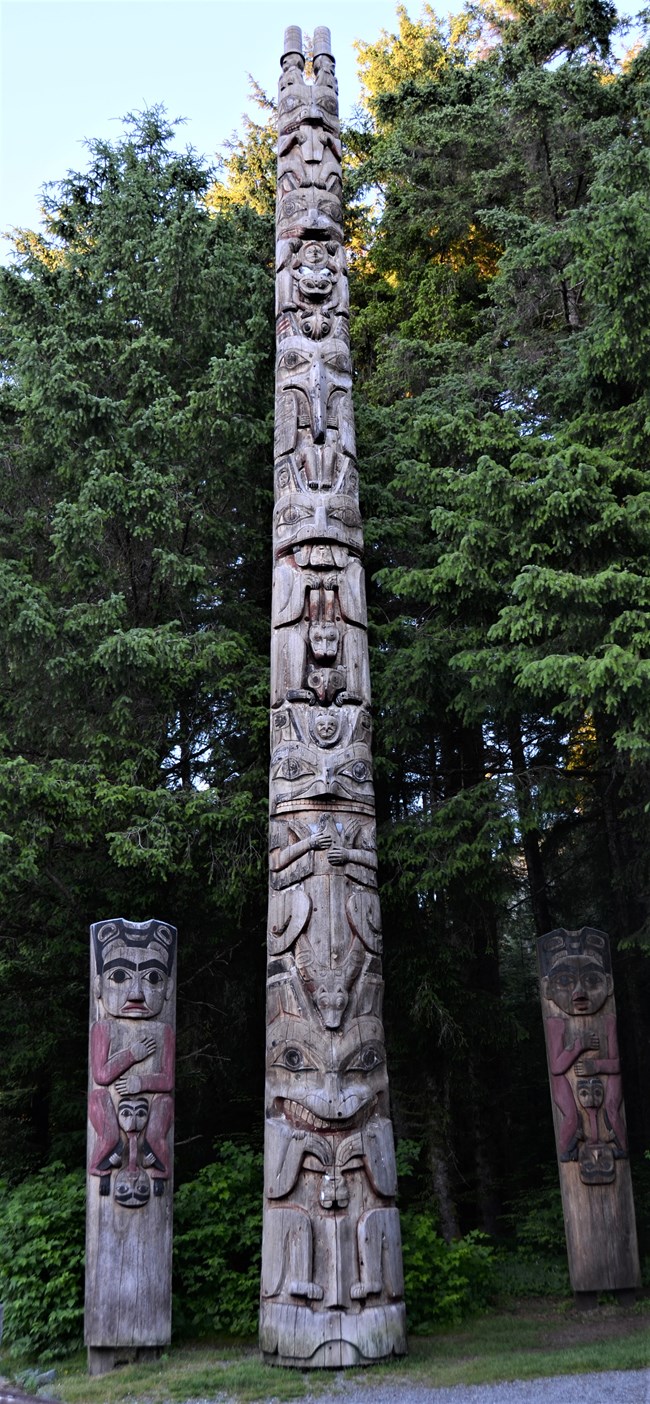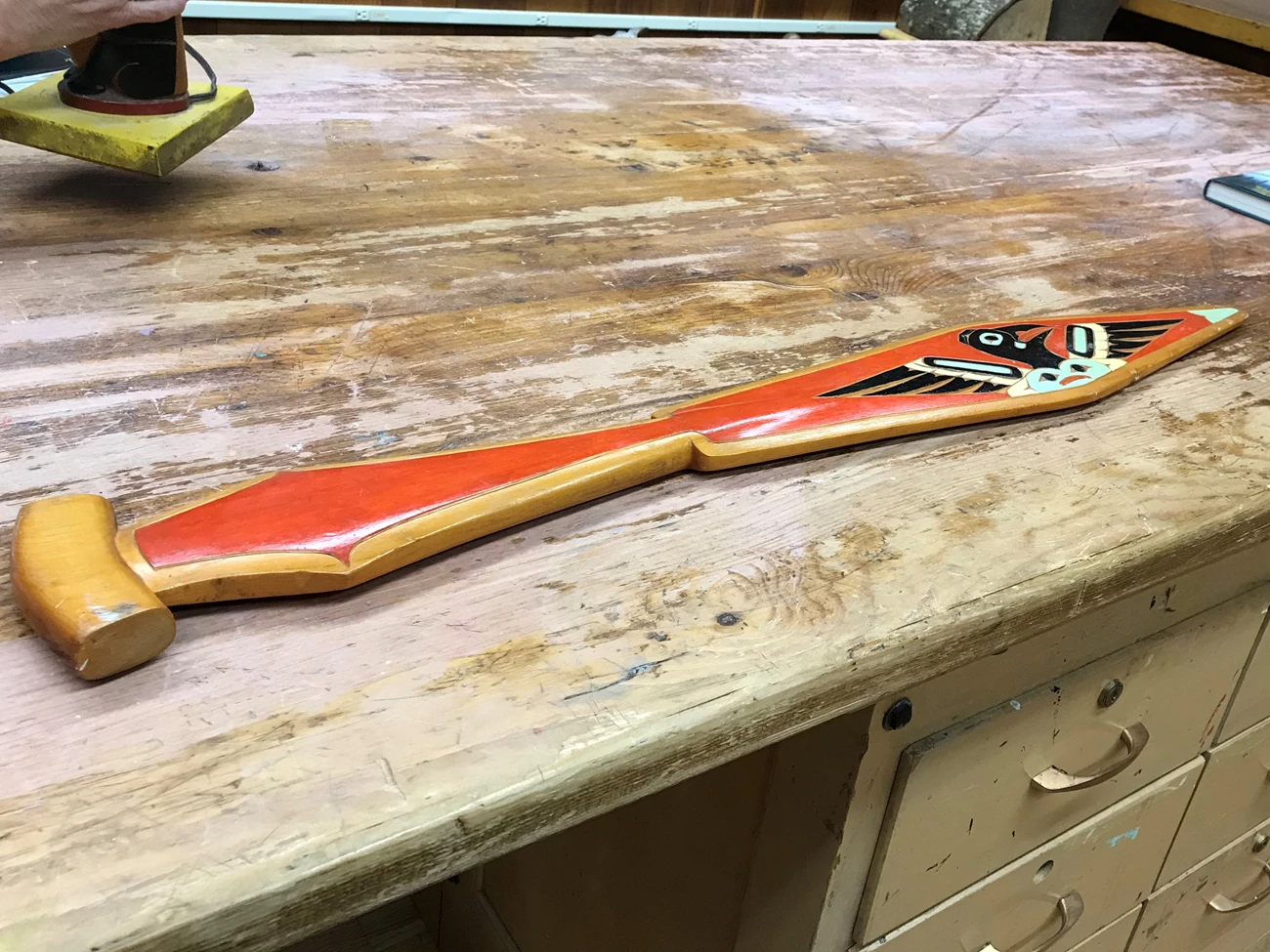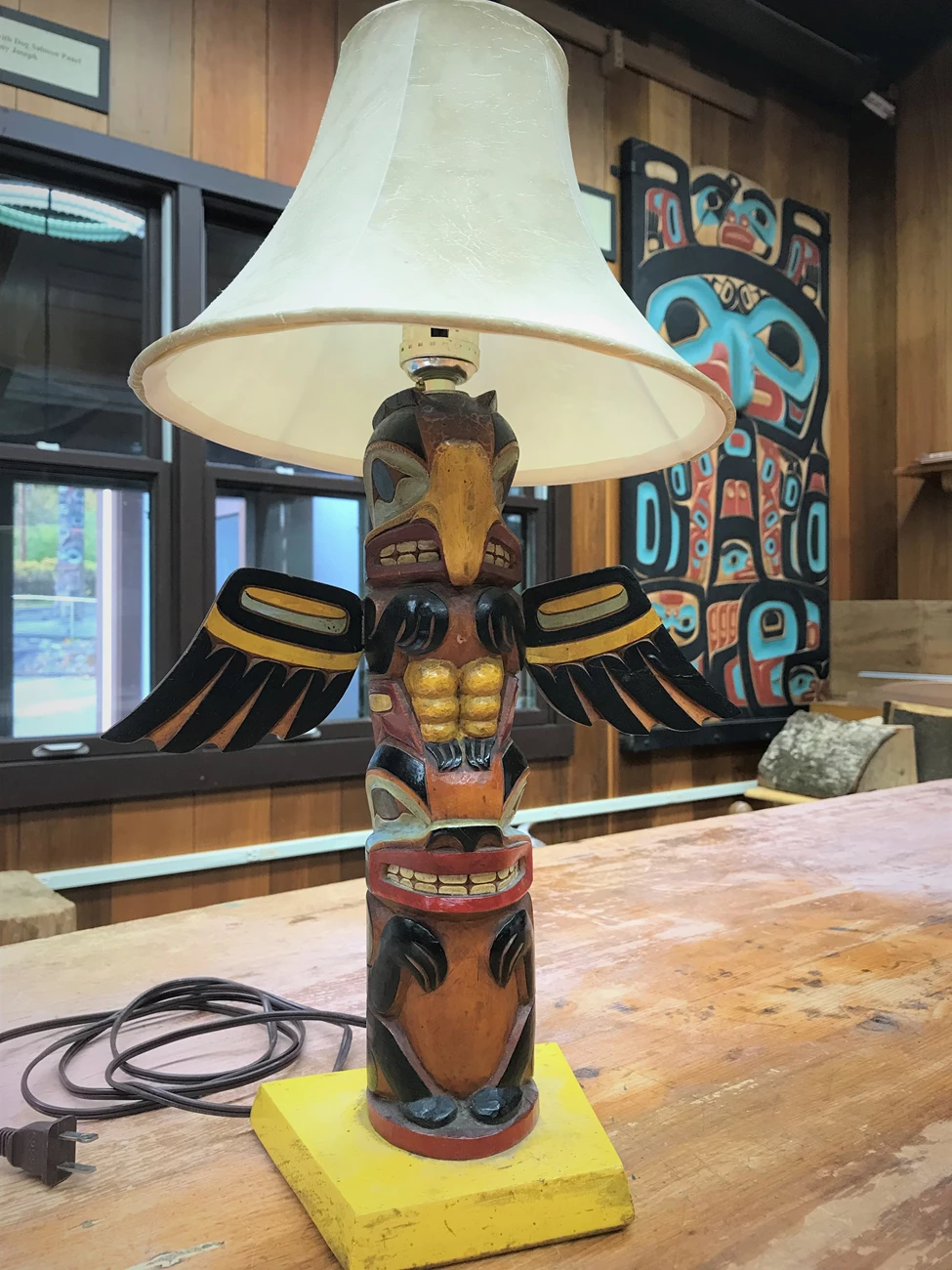Last updated: April 2, 2022
Article
The Legacy of George Benson (Lkeináa), Tlingit Carver and Community Mentor

Sitka National Historical Park Archives
Traditional Artist
President Franklin Roosevelt established the Civilian Conservation Corp (CCC) in April 1933 to help tackle high unemployment caused by the Great Depression. During these unsettling times, people were employed to work on environmental conservation projects across the United States. Between 1938 and 1941, the CCC hired mostly local Alaska Native workers to restore and, in a few cases, re-carve totem poles, that had deteriorated in the elements over time, in what was then Sitka National Monument (now, Sitka National Historical Park).
The New Deal restoration project not only aimed to provide economic aid to Native people during the Depression, but it also reversed the government’s policies on repressing Native cultural practices by recasting traditional art as part of America’s heritage.
The carvers with the CCC were, in a sense, able to bridge the gap for a tradition that could have been lost during the era of “Americanization” in the early days of United States governance of Alaska (beginning in 1867). In his 2012 volume, The Most Striking of Objects: The Totem Poles of Sitka National Historical Park, Andrew Patrick notes that the conversion of many Alaska Natives to Christianity also contributed to the disappearance of carving traditions. For many native communities, entire generations, spanning over 100 years experienced a disconnect from their culture, due to assimilation efforts of Christian missionaries, which was supported by the United States government, and the art of totem carving nearly reached the point of extinction.
Many of the poles that the CCC recovered were found in an advanced state deterioration, which made conservation difficult. While restoration was the preferred approach, the CCC opted for re-carving, or partial re-carving, if the pole could not be salvaged. The head carver at Sitka was George Benson (Lkeináa), a master carver, enlisted to train young recruits in the craft of totem carving, thus helping preserve not only Native artifacts, but also cultural practices.
Mr. Benson is well known for his work in the restoration and re-carving of poles in Sitka National Monument. He attributed the development of his skills to his work on the large “monumental” poles during the CCC era. The Frog/ Raven Pole, Saanaheit Pole, Trader Legend Pole, and Waas’go Legend Pole were re-carved by George and his CCC team. These can still be seen in the park today, over 80 years later. Mr. Benson was not only a craftsman who carved replicas. He also proved himself as a skilled designer, with intimate knowledge of the concepts of Northwest Coast formline design elements. He is the designer of the “Baranof Pole” a feature in Sitka’s downtown “Totem Square”.

NPS, Sitka National Historical Park, SITK 14609
Family and Community
In a recent interview with George Benson’s youngest daughter, Lorraine Chartrand, and his eldest granddaughter Georgina Kitka, we were given the gift of insight. Lorraine and Georgina shared fond memories and stories of the man that we cannot get from books or research papers.
Lorraine, a small woman with a gentle voice and friendly eyes, was filled with many warm memories of her father. Georgina, her caring and loving niece, brought pictures and objects to share, and helped her aunt remember details.
Mr. Benson was born in Yakutat in 1900. His mother died when he was very young. He was passed around between a few aunts for a short while, and eventually came to Sitka, where he remained in the care of the Russian Orphanage. In this orphanage he was raised in the Orthodox faith, which he continued to follow throughout his life, and raised his children to do the same.
According to daughter Lorraine, her father didn’t speak much about his childhood or his initial training as a carver. “I think he was bored and just kind of picked it up for something to do.” Between his daughter and granddaughter, they couldn’t recall any stories or details he might have shared about his work with the CCC. Georgina commented “It was probably just a job for him, like all of the other work he did.” Aside from carving, Mr. Benson constructed boats, fished, hunted, he worked as a janitor at Mt. Edgecumbe Hospital, and worked in various construction or laborer positions. He was foreman of the CCC team that built the seawall in front of Totem Square along the Katlian street waterfront in Sitka.
George Benson worked very hard to support his large family. He and his wife, Mary Williams were married in 1920 and had seven children- five daughters and two sons. Georgina shared that her grandparent’s marriage was arranged, as was the tradition, and it was comforting to see an arranged marriage that lasted forever. “I was an arranged child” Lorraine laughed.
George Benson wasn’t ALL work, though. Both women described him as laid back and easy going. According to both, he was a devoted family man, who enjoyed the company of his children and grandchildren, and took the time to share with them some Tlingit traditional foods and medicines. Lorraine reminisced about taking frequent long walks with her father, sometimes picking salmonberries, and in the spring the little salmonberry sprouts to eat “you have to pick them early before they get woody”. Lorraine remembers her father harvesting the roots of a plant, she can’t remember which (“when you are young you don’t pay close attention”) and taking the tubers home. He cleaned them, scraped them, and then boiled them all day long. “Then he would drink the juice. I tasted it- it was very bitter. He said it was good for his hands, for his arthritis.” Typically a happy and talkative person who liked to show people his boxing moves, the only thing he ever complained about was the arthritis in his hands. "My hands are no good" he would say.
Mr. Benson was a very social person whose creativity wasn’t limited to carving. He was a member of the Alaska Native Brotherhood (ANB) and would play with the band when they had dances at the ANB Hall. He played guitar and harmonica. When neighbors had parties, he took his children, and they would enjoy music and native dancing.
When asked about what Mr. Benson would have considered his favorite accomplishments, Lorraine answered that he was very proud of the fact that he made his own carving tools. Shaping blades, carving the handles, and binding them together with twine. He also loved to cook for his family, and prepared traditional foods, like seal, herring and salmon eggs and Hudson Bay tea.
Despite the challenges of hearing loss and arthritis, Mr. Benson continued to carve through most of his life. For his family he made gifts, like the lamp and paddle pictured at the end of this article. “He made one for each of his daughters. They are all similar- they all have Eagles because he told us we are Eagles.” He made useful items for his home, and other items that he sold. Georgina shared that her husband, Harvey Kitka, went to the Smithsonian National Museum of the American Indian and saw one of his spoons there. “His work is still found in many places.”

NPS Photo/ Cinnamon Dockham
Mentor
Mr. Benson’s contribution to the Native art community of Sitka is legendary. Following the dissolution of the CCC, he was one of the few carvers who continued to use his art to support his family. With the onset of increased tourism post WWII, he made his living carving small replica poles for tourists to purchase. “He took orders from visitors and would have to ship them.” In 1965, with the addition of a new Visitor Center at Sitka National Historical Park, he began working as a demonstrating artist and teacher in the new wing, dedicated to a Native Arts program. Here he had the opportunity to teach the public that Native art is more than “a curiosity”. He was instrumental in representing traditional carving styles that represented those of Northwest Coast cultures, differentiating them from the ivory carving techniques of northern Alaskan (Inupiaq) cultures. He became a mentor and teacher for the next generation of carvers, working with the Southeast Alaska Indian Cultural Center (SEAICC), teaching art forms appropriate to the historic cultures of Southeast Alaska.
Sometimes the instruction he provided for fellow artists happened informally while he was at home. In the Benson home, there were frequents guests. People came from all over Southeast Alaska to visit and talk with Mr. Benson in his studio. He spoke Tlingit at home, and shared stories and talked about what he was working on as he carved. “He had an ‘open door policy’ where people could just stop in any time.” Georgina said. “Our house smelled like yellow cedar because he was carving a lot” Lorraine remembers. He loved being surrounded by community, friends, and family.
George Benson’s efforts to teach Tlingit (not “Eskimo”) carving in SEAICC and advocating for proper management of the Native arts program through the Sitka chapter of the Alaska Native Brotherhood, rather than the Indian Arts and Crafts Board, benefitted future generations of Tlingit and Haida carvers. This action of making a point to differentiate the separate Alaska Native cultures and art forms began the dawn of enlightenment for visitors from other places.
In the book “Proud Raven, Panting Wolf- Carving Alaska’s New Deal Totem Parks” the author Emily L. Moore, an adopted Kiks.ádi clan member, discusses how “Tlingit and Haida leaders were able to channel the New Deal promotion of Native art as national art into an assertion of their cultural and political rights. Just as they had for centuries, the poles affirmed the ancestral ties of the Haida and Tlingit lineages to their lands.” Moore cites George Benson’s role as a carver, advocate, and mentor as truly significant to that era.

NPS Photo
Legacy
George Benson’s legacy continues in Sitka National Historical Park through the active preservation of poles, to include re-carving by local Native artists when warranted. Visitors are offered a glimpse into the complexity and richness of Northwest Coast/ Southeast Alaskan arts and history through exhibits, programs, and demonstrations.
Mr. Benson’s family still enjoys spending time in the park. Lorraine loves walking on the trail among the totem poles and exploring the shore at low tide. Georgina appreciates the timelessness of the place, and how it seems to not have changed much over the years. Both appreciate the preservation aspect of the park’s Visitor Center, protecting the original poles from the natural elements so they can still be enjoyed.
Mr. Benson’s creative legacy also continues through his family. Lorraine believes that George’s father, Daniel Benson, was a carver in Yakutat and that creativity and carving runs through their blood. He influenced his children and grandchildren to explore their creativity. His son William Burkhart, who carved and painted the above pictured "Sea Pidgeon" panel which is displayed in the park, William's son Lee, who works with his dad on canoes, and also carves and sells gold and silver metal jewelry. His grandson David Galanin, and David’s sons Jarrod and Nicholas Galanin have all become well known artists who carve precious metals, among several other artistic pursuits. Their art has been featured in museums and cultural centers all over the Pacific Northwest. Lorraine feels her grandson, Scott, has many of George’s personality traits and may continue the tradition of creativity. Georgina claims her grandfather “would be very proud to see that his grandchildren are following in his footsteps.”

NPS Photo/ Cinnamon Dockham

NPS Photo/ Cinnamon Dockham
